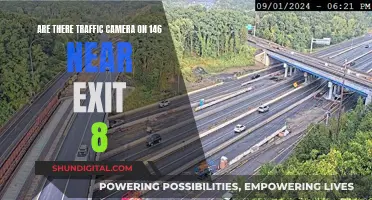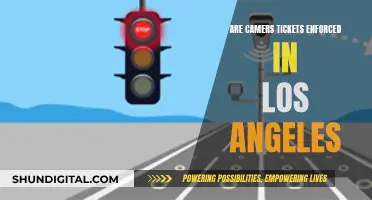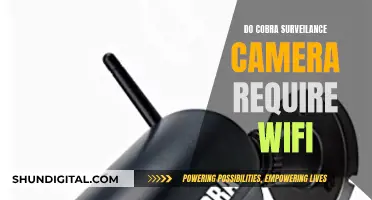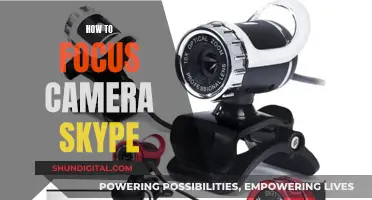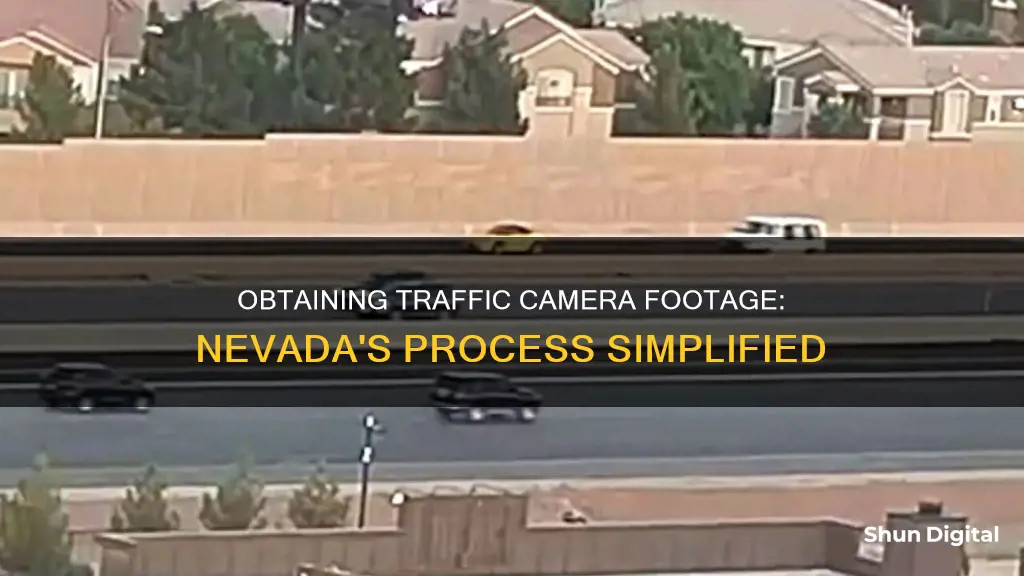
Traffic cameras are an essential tool for monitoring and managing traffic flow, and Nevada has a comprehensive network of these cameras. While the footage is primarily used for surveillance and traffic management, it can also be requested by members of the public. This article will outline the process of obtaining traffic camera footage in Nevada, including the relevant authorities to contact and the expected response times. It is important to note that while traffic cameras are used for traffic enforcement in many states, Nevada has specific laws prohibiting their use for issuing traffic infractions.
| Characteristics | Values |
|---|---|
| Purpose | To help drivers make informed decisions about their route and avoid delays |
| Camera Locations | Major roadways throughout Nevada |
| Camera Operators | Nevada Department of Transportation (NDOT) |
| Camera Types | Live Traffic Cameras |
| Additional Features | Freeway digital message signs, Highway Advisory Radio, freeway ramp meters |
| Contact | Phone: (702) 901-8400 |
| Address | 4615 W Sunset Rd Las Vegas, NV 89118 |
| Hours | Monday-Friday 5:00 AM – 11:00 PM |
| Saturday 6:00 AM – 11:00 PM | |
| Sunday 7:00 AM – 11:00 PM | |
| Website | Nevada Department of Transportation |
| publicrecordsreq@dot.nv.gov |
What You'll Learn

How to obtain traffic camera footage in Nevada: a step-by-step guide
Step 1: Identify the specific traffic camera(s)
To obtain traffic camera footage in Nevada, the first step is to identify the specific camera(s) that may have captured the incident or location of interest. Nevada has a statewide network of traffic cameras operated by the Nevada Department of Transportation (NDOT) and various local agencies, such as the Regional Transportation Commission (RTC) in Southern Nevada.
Step 2: Determine the agency responsible for the camera(s)
Once you have identified the specific camera(s), you need to determine which agency is responsible for managing and maintaining those cameras. This can be either NDOT or local agencies like RTC.
Step 3: Submit a Public Records Request
After identifying the responsible agency, the next step is to submit a Public Records Request to obtain the desired footage. The process for submitting a request may vary depending on the agency.
For NDOT, you can submit a Public Records Request by mail, email, or in person:
- Mail or In-Person Delivery:
- Nevada Department of Transportation
- Attn: Records Management
- 1263 South Stewart Street
- Carson City, NV 89712
- Email: publicrecordsreq@dot.nv.gov
For RTC, you can find information on submitting Public Records Requests on their website: https://www.rtcsnv.com.
Step 4: Provide detailed information about your request
When submitting your Public Records Request, be sure to include as much detailed information as possible to help expedite the process. This includes providing specific dates, time frames, locations, and any other relevant details related to the footage you are requesting.
Step 5: Follow up on your request
After submitting your request, you may receive an initial response within a few days, and the processing time for requests can vary. It is important to follow up on your request if you have any questions or do not receive a response within a reasonable timeframe. The contact information for the relevant agencies can be used for follow-up inquiries.
It is important to note that traffic camera footage is typically managed and released in accordance with public records laws and the policies of the respective agencies. There may be restrictions on the use of the footage obtained, and it is important to respect the privacy and legal rights of any individuals captured in the footage.
Hacking Traffic Cameras: A Step-by-Step Guide to Accessing Footage
You may want to see also

Public records requests in Nevada: what you need to know
The Nevada Department of Transportation (NDOT) offers live traffic camera feeds to help drivers make informed decisions about their routes and avoid delays. These traffic cameras are part of NDOT's statewide network of Intelligent Transportation Systems, which also includes freeway digital message signs, Highway Advisory Radio, freeway ramp meters, and more.
To obtain traffic camera footage in Nevada, you can submit a public records request to the NDOT Records Management Section. This department is responsible for assisting the public in accessing NDOT's public records. Here are some important things to know about the process:
- Contact Information: You can submit your request via email at publicrecordsreq@dot.nv.gov or by mail to Nevada Department of Transportation (NDOT), Attn: Records Management, 1263 South Stewart Street, Carson City, NV 89712.
- Request Guidelines: NDOT recommends submitting your request through their website or by email. Your contact information, including a legible handwritten or typewritten request, is necessary to complete the process. It is helpful to be as concise as possible and provide specific details such as contract or project numbers, date ranges, and subject matter to expedite the process.
- Response Time: Once you submit your request, you will receive an initial response email within five calendar days. Due to the volume of requests, the current expected turnaround time to provide response records is three weeks. The NDOT team may reach out to you for clarification during this process.
- Live Traffic Cameras: If you are looking for real-time traffic information, you can visit the NDOT 511 page or dial 511 or 1-877-NV-ROADS before your drive. This service provides live traffic camera feeds and updates on road conditions, helping you make informed travel decisions.
Traffic Cameras: Unveiling the Secrets of Their Identification Methods
You may want to see also

Live traffic camera feeds: how to access real-time footage
Live traffic camera feeds are a useful way to check road conditions and make informed decisions about your route. In Nevada, there are several ways to access real-time traffic camera footage.
Nevada Department of Transportation (NDOT)
The Nevada Department of Transportation (NDOT) offers live traffic camera feeds as part of its Intelligent Transportation Systems. These cameras provide drivers with information on road conditions, such as congestion, incidents, extreme weather, and other potential delays.
To access NDOT's live traffic camera feeds, you can visit their website or dial 511 or 1-877-NV-ROADS before your trip to check the latest road conditions.
Regional Transportation Commission (RTC)
The Regional Transportation Commission (RTC) is responsible for overseeing transportation planning in Southern Nevada. Their Freeway and Arterial System of Transportation (FAST) is an integrated Intelligent Transportation System that uses live traffic camera feeds for real-time monitoring of freeways and arterials.
To access RTC's live traffic camera footage, you can visit their website or download the rideRTC app. You can also follow them on Twitter for #FASTALERTS and subscribe to their blog for the latest updates.
Las Vegas Advisor
While live traffic camera feeds are not directly accessible through the Las Vegas Advisor website, they provide useful information about traffic cameras in Las Vegas. According to their website, major intersections in Las Vegas are under video-traffic-camera surveillance. However, these cameras are currently used for surveillance purposes only, allowing commuters and drivers to make travel decisions based on road conditions.
In summary, accessing live traffic camera feeds in Nevada can be achieved through the websites and services provided by NDOT and RTC. These organizations provide real-time traffic camera footage to help drivers make informed decisions about their routes and stay updated on road conditions.
Roku and Wyze: What's the Camera Connection?
You may want to see also

The legality of red-light traffic cameras in Nevada
Red-light traffic cameras are a type of traffic enforcement camera that captures vehicles that have entered an intersection after the signal has turned red. These cameras are used worldwide, including in Nevada. While they are intended to improve road safety, their use is controversial, with questions raised about public safety, privacy, and drivers' rights.
In Nevada, red-light traffic cameras are prohibited with limited exceptions. The state allows traffic cameras to be installed in the vehicle or facility of a law enforcement agency or to be hand-held by a police officer. This means that while red-light traffic cameras are not typically allowed, there are specific circumstances in which they may be used.
The Nevada Department of Transportation (NDOT) offers live traffic cameras to provide drivers with real-time traffic information, such as congestion, incidents, and road conditions. These cameras are part of NDOT's Intelligent Transportation Systems, which also include freeway digital message signs and highway advisory radio. While these cameras provide valuable information for commuters, they are not typically used for red-light enforcement.
To obtain traffic camera footage in Nevada, you can submit a public records request to the NDOT. The NDOT Records Management Section assists the public in accessing public records, and you can find the necessary contact information and guidelines on their website. It is important to note that traffic camera footage is provided for informational purposes and may not be used as evidence in all states, including Nevada, due to specific regulations regarding red-light traffic cameras.
Best Action Cameras for Extended Recording Sessions
You may want to see also

How traffic cameras improve road safety and mobility
Traffic cameras are an effective way to improve road safety and mobility. They can help monitor and manage traffic flow, reduce accidents and injuries, and provide valuable data for transportation planning and improvements.
In Nevada, the Department of Transportation (NDOT) operates a network of traffic cameras as part of its Intelligent Transportation Systems (ITS). These cameras provide live feeds from major roadways, helping drivers make informed decisions about their routes and enabling them to avoid congestion, incidents, or adverse weather conditions. This not only improves the efficiency of their commute but also enhances road safety by reducing potential traffic hazards.
The use of traffic cameras has been a subject of debate, with some arguing that they invade privacy and are used for revenue generation through fines. However, studies have shown that they can be effective in reducing speeding and red-light running, which are significant contributors to accidents. For example, a study in Virginia found that red-light cameras reduced the number of drivers running red lights by 67%. Additionally, a review of studies by the British Medical Journal concluded that speed cameras effectively reduced accidents and injuries, recommending their wider deployment.
While there may be mixed results regarding the impact of cameras on overall accident numbers, they can still play a crucial role in improving road safety. For instance, a study in Houston, Texas, found that while angle accidents (T-bone collisions) increased by 26% after the removal of cameras, all other types of accidents decreased by 18%. This suggests that the benefits of camera programs can vary depending on specific locations and contexts.
Furthermore, traffic cameras can provide valuable data for transportation authorities to make informed decisions about road improvements and safety measures. The data collected can help identify frequent congestion areas, accident hotspots, and areas where additional safety measures may be required. This enables transportation agencies to allocate resources effectively and implement targeted solutions.
In summary, traffic cameras are a valuable tool for improving road safety and mobility. They help drivers make informed decisions, reduce speeding and red-light violations, and provide critical data for transportation planning and improvements. While there may be concerns about privacy and revenue generation, the overall positive impact on road safety and mobility justifies their use.
Car Camera Benefits: Safety, Security, and Peace of Mind
You may want to see also
Frequently asked questions
The Nevada Department of Transportation (NDOT) offers live traffic cameras that can be accessed through their 511 page. This provides live traffic camera feeds for major roadways throughout Nevada.
The NDOT Records Management Section assists the public in accessing NDOT's public records. You can submit a public records request via an online form or by emailing publicrecordsreq@dot.nv.gov.
No, a 1999 statewide law bans the use of remotely controlled cameras to gather evidence against drivers who run red lights or are involved in accidents. Nevada prohibits the use of all imaging equipment unless it's handheld by an officer or installed in a vehicle or facility of a law enforcement agency.


